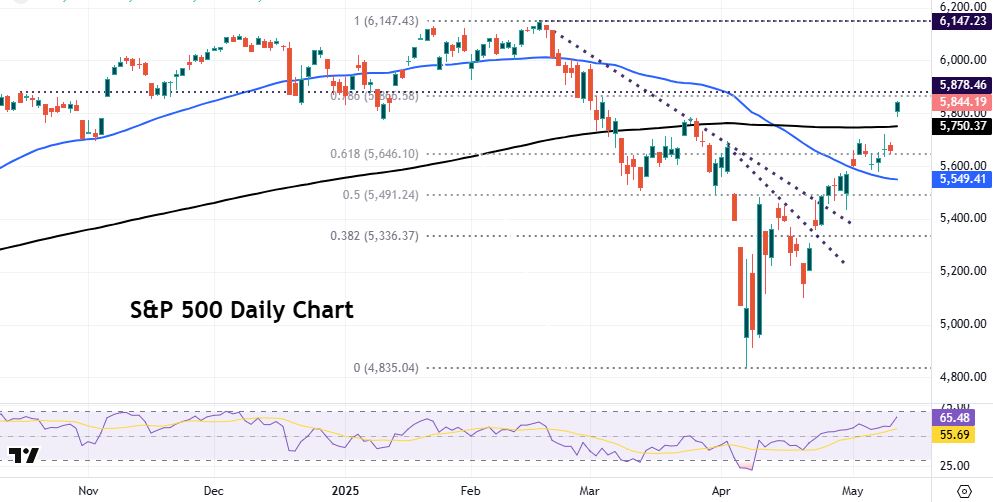Risk-on as US and China de-escalate trade war

- Stocks soar as US and China agree 90-day tariff relief
- Dollar surges after Sino-US truce improves growth outlook
- Treasury yields jump as Fed rate cuts bets get pared back
- Gold slides on trade optimism though uncertainty remains
FX: USD enjoyed its biggest jump since November, as it burst higher out of the bear channel that had been in play since early February. A substantial cooling of trade tensions – 115ppts 90-day tariff reduction – between the US and China brought the dollar bulls out. The tariff climbdown was a bigger than expected de-escalation (consensus thought tariffs would be 50-60%) so an upgrade to the outlook took place. Fed rate cut bets for 2025 got pared back to around 57bps from 72bp on Friday.
EUR broke down through support around 1.1243, seeing its biggest one-day drop since early November. Central bank policy is under the spotlight as optimism over the Sino-US talks has pushed Fed rate cuts back out. Elsewhere, we note that Trump has ramped up pressure on Russia to agree to a 30-day truce, and Ukrainian President Zelenskyy said he’ll be “waiting for” Putin in Turkey on Thursday. That’s very unlikely to happen. The 50-day SMA in EUR/USD is 1.1072.
GBP pulled back some of its losses and finished midpack in the majors. The improved trade picture for the UK has recently helped sterling. A better risk mood and the upcoming EU-UK summit on May 19 also underpins pound support, certainly against its non-USD peers.
USD/JPY surged higher as the major broke a downward trendline from the year-to-date top in January at 158.87. Prices also pushed north above a major Fib level (38.2%) of this year’s decline at 147.13, which now acts as initial support. Safe havens got shunned in favour of riskier currencies.
AUD was a relative outperformer, so to CAD. The latter touched the 200-day SMA at 0.6457 before settling near its lows below 0.64. The loonie was the best performing major aside the USD. But the major enjoyed a third straight of gains as US-Canada yield spreads continued to widen as markets reined in expectations of Fed easing.
US stocks: The S&P 500 gained 3.26% to settle at 5,844. The tech-laden Nasdaq finished up 4.02% at 20,868. The Dow closed 2.81% higher at 42,410. The VIX dropped sharply to 18.4, very close to its long-term average. It was very much a risk-on session as only one sector was in the red, utilities while consumer discretionary, tech and communication services led the way, with gains of 5.7%, 4.7% and 3.4% respectively. The S&P 500 and Nasdaq broke their 200-day SMAs for the first time since late March. The latter closed more than 22% above its lowest session close in the April tariff sell-off. It is still 8% below its record close. Amazon was the big Mag7 winner, up over 8%, with Meta adding 7.9% and Tesla 6.8%. Apple gained 6.2% and was said to be weighing price increases for its autumn iPhone line-up.
Asian stocks: Futures are green. Asian markets rallied Monday as US-China trade negotiations concluded positively. The Hang Seng jumped 2.9%, marking its eighth consecutive gain. China’s CSI 300 and Shanghai Composite added about 1.1% and 0.9%, respectively. Further upside was capped by a lack of detail at the time and China data showed ongoing deflation. The Nikkei 225 underperformed as initial gains were wiped out. Pharmaceutical stocks dropped after President Trump announced plans to cut drug prices immediately, by 30-80%.
Gold tanked, down over 3% at one point intraday. Dollar and bond yield strength hurt bugs. The potential ‘double top’ reversal pattern in play could point to $300 of downside from around $3,200.
Day Ahead – UK Jobs, US CPI
UK unemployment is forecast to rise, though there are still reliability issues with this data. Crucially, total pay growth is expected to cool to 5.2% from 5.6% due to base effects, while regular pay growth is expected to fall to 5.6%. That said, wage growth remains elevated and even though the job market is cooling, it’s less than many hoped, especially after the recent tax hikes.
Expectations are for the US headline CPI to rise 0.3% m/m and 2.4% y/y. Core prices are forecast to print at 0.3% and 3%. There may evidence of pre-emptive price hikes but general uncertainty around the timing and size of tariffs impacting prices is tough to gauge at present. Typically, the pass-through of tariffs to higher prices takes a few months to show up in hard inflation data. April would reflect two months following the start of new tariffs this year, which began with 10% on imports from China in February. However, it would likely be too soon to reflect price increases from new tariffs in April.
Chart of the Day – S&P 500 marches on…
It has been some rebound in risk and stock markets from the lows just five weeks ago in early April. Prices plunged to a trough at 4,835, which was down just over 20% from the record high at 6,147 from mid-February. That size of sell-off is deemed a bear market – and many market watchers believe it hastened President Trump’s rollback of numerous trade announcements as well as the 90-day pause. The benchmark S&P 500 recent bull move has broken a couple of downward trendlines and gapped higher through the 200-day SMA at 5,750 to kick off this week. The final Fib level (78.6%) of this year’s down move sits at 5,866, plus a swing high just above, and both ahead of the record high at 6,147. Support is the major retracement level (61.8%) at 5,646.

